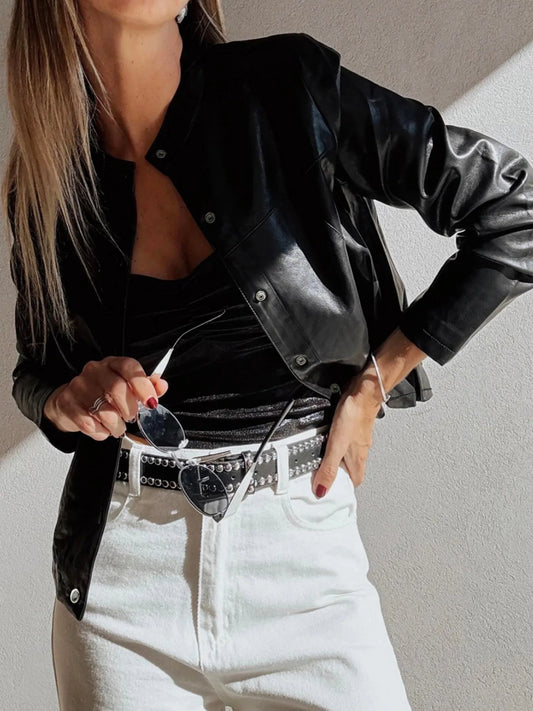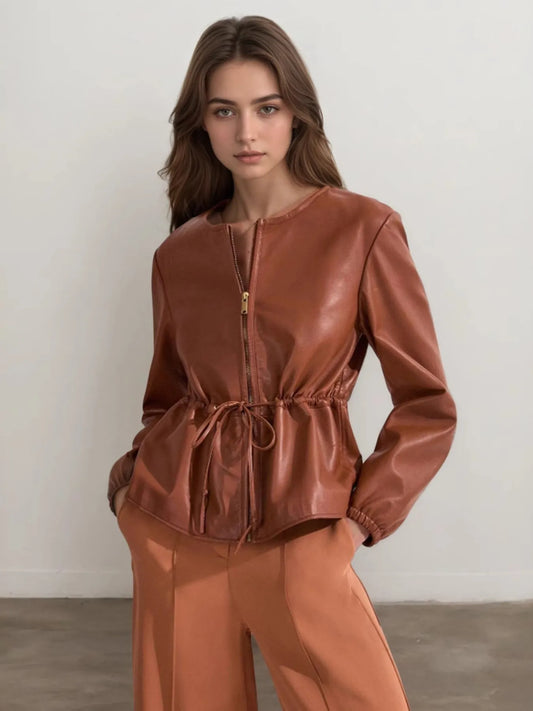Shop Faux Leather Jackets
-
Color Block Pu Leather Jacket
Regular price $35.95 USDRegular priceUnit price / per$71.99 USDSale price $35.95 USDSale -
Zip Up Leather Bomber Jacket
Regular price $122.00 USDRegular priceUnit price / per$243.99 USDSale price $122.00 USDSale -
Solid Suit Lapel Faux Suede Leather Jacket
Regular price $107.00 USDRegular priceUnit price / per$213.99 USDSale price $107.00 USDSale -
Woman Fashion Hooded Faux Leather Jacket
Regular price $66.00 USDRegular priceUnit price / per$131.99 USDSale price $66.00 USDSale -
Open Front Leather Jacket & Dress Set
Regular price $59.00 USDRegular priceUnit price / per$117.99 USDSale price $59.00 USDSale -
Zip Up Leather Jacket
Regular price $129.00 USDRegular priceUnit price / per$257.99 USDSale price $129.00 USDSale -
Chicory Coffee Double Flap Pocket Drawstring Hem Leather Jacket
Regular price $58.88 USDRegular priceUnit price / per$117.99 USDSale price $58.88 USDSale -
Leather Zip Up Jacket
Regular price $100.00 USDRegular priceUnit price / per$199.99 USDSale price $100.00 USDSale -
Faux Leather Buttoned Front Boxy Jacket
Regular price $86.00 USDRegular priceUnit price / per$171.99 USDSale price $86.00 USDSale -
Black Faux Leather Buttoned Front Boxy Jacket
Regular price $79.07 USDRegular priceUnit price / per$157.99 USDSale price $79.07 USDSale -
Drawstring Zip Up Leather Jacket
Regular price $73.00 USDRegular priceUnit price / per$145.99 USDSale price $73.00 USDSale -
Leather Belted Trench Jacket
Regular price $136.00 USDRegular priceUnit price / per$271.99 USDSale price $136.00 USDSale -
Davi & Dani Faux Leather Button Up Jacket With Chest Pockets
Regular price $96.00 USDRegular priceUnit price / per$186.00 USDSale price $96.00 USDSale -
Blue Zone Planet | Love Me Now Pu Leather Contrast Snap Down Bomber Jacket
Regular price $47.00 USDRegular priceUnit price / per$72.00 USDSale price $47.00 USDSale -
Blue Zone Planet | Snobbish Charcoal Pu Leather Biker Jacket With Side Zip Pockets
Regular price $45.00 USDRegular priceUnit price / per$70.00 USDSale price $45.00 USDSale -
Blue Zone Planet | How Dare U Drawstring Hem Pu Leather Zip Up Jacket
Regular price $51.00 USDRegular priceUnit price / per$79.00 USDSale price $51.00 USDSale -
Blue Zone Planet | Snobbish Faux Leather Zip Up Drawstring Hooded Jacket
Regular price $54.00 USDRegular priceUnit price / per$83.00 USDSale price $54.00 USDSale -
Blue Zone Planet | Love Me Now Pu Leather Contrast Snap Down Bomber Jacket
Regular price $47.00 USDRegular priceUnit price / per$72.00 USDSale price $47.00 USDSale -
Blue Zone Planet | Love Me Now Pu Leather Contrast Snap Down Bomber Jacket
Regular price $47.00 USDRegular priceUnit price / per$72.00 USDSale price $47.00 USDSale -
Blue Zone Planet | Snobbish Snap Down Long Sleeve Pu Leather Jacket
Regular price $42.00 USDRegular priceUnit price / per$65.00 USDSale price $42.00 USDSale -
Blue Zone Planet | Love Me Now Pu Leather Contrast Snap Down Bomber Jacket
Regular price $47.00 USDRegular priceUnit price / per$72.00 USDSale price $47.00 USDSale -
Blue Zone Planet | Snobbish Snap Down Long Sleeve Pu Leather Jacket
Regular price $42.00 USDRegular priceUnit price / per$65.00 USDSale price $42.00 USDSale -
Blue Zone Planet | How Dare U Drawstring Hem Pu Leather Zip Up Jacket
Regular price $51.00 USDRegular priceUnit price / per$79.00 USDSale price $51.00 USDSale -
Blue Zone Planet | How Dare U Drawstring Hem Pu Leather Zip Up Jacket
Regular price $51.00 USDRegular priceUnit price / per$79.00 USDSale price $51.00 USDSale
Collection: Shop Faux Leather Jackets
Do PU Leather Jackets Keep You Warm?
In the ever-evolving world of fashion and technology, one question that often surfaces is the effectiveness of PU (Polyurethane) leather coats in providing warmth. With the increasing awareness and demand for sustainable and cruelty-free alternatives to traditional leather, PU leather has become a popular choice. But does it hold up when it comes to insulation and warmth? This article delves into the science and opinions behind PU leather's thermal properties, its comparison with genuine leather, and the factors influencing its performance as a winter garment.
Understanding PU Leather
PU leather, also known as synthetic leather, is made by coating a fabric like polyester or cotton with a flexible polymer. It is then treated to mimic the texture and color of animal leather. Unlike PVC leather, another type of synthetic leather, PU leather is more breathable and flexible, making it more comfortable for clothing.
Thermal Properties of PU Leather
The key to understanding the warmth of any material lies in its thermal properties. Genuine leather, which is animal hide, has natural insulating properties due to its porous nature, allowing for air retention that aids in warmth. PU leather, on the other hand, lacks these natural pores. However, this does not automatically disqualify it as a warm material.
1. Insulation:
The insulation capability of PU leather largely depends on its backing material and thickness. A thicker PU layer or a denser backing material can trap more air, providing better insulation. Some PU leather coats come with additional lining materials like fleece or synthetic fur, which significantly enhance their warmth.
2. Wind Resistance:
One area where PU leather excels is in wind resistance. Its synthetic nature provides a solid barrier against cold winds, which is a crucial factor in maintaining warmth in colder climates.
3. Breathability:
Breathability is a double-edged sword. While genuine leather's porous nature allows for better breathability, which can be a boon in mild weather, it can lead to heat loss in colder conditions. PU leather's lesser breathability can, therefore, be an advantage in trapping heat, provided it is not at the cost of comfort.
Comparing PU Leather and Genuine Leather
Regarding warmth, genuine leather generally has the upper hand due to its natural insulating properties. However, modern advancements in PU leather manufacturing have narrowed this gap. High-quality PU leather can come close to genuine leather in terms of warmth, especially when combined with the right linings and thickness.
1. Sustainability:
An added advantage of PU leather is its sustainability aspect. With growing environmental concerns and ethical considerations regarding animal products, PU leather offers a guilt-free alternative for the eco-conscious consumer.
2. Maintenance and Durability:
PU leather is easier to maintain and is less prone to cracking compared to genuine leather. However, it may not have the same longevity. This trade-off is an essential consideration for consumers prioritizing either durability or ease of care.
3. Cost:
Generally, PU leather is more affordable than genuine leather, making it an accessible option for those who prioritize budget without significantly compromising style and warmth.
Real-World Experiences
Consumer experiences vary widely with PU leather coats. Some users swear by their PU leather jackets for moderate cold, praising their wind resistance and stylish appearance. Others find them lacking in severe winter conditions unless properly layered. The consensus leans towards PU leather being suitable for mild to moderate cold weather but not as the sole protection against extreme cold.
Key Points to Understand
-
Insulation Depends on Quality and Lining: A PU leather coat's warmth depends on the PU layer's thickness, the density of the backing material, and any additional lining.
-
Effective Wind Resistance: PU leather offers excellent wind resistance, which is a significant factor in retaining warmth.
-
A Sustainable and Affordable Alternative: PU leather is a more sustainable and cost-effective alternative to genuine leather, aligning with ethical and environmental considerations.
In conclusion, while PU leather may not inherently match the natural insulating properties of genuine leather, advancements in its manufacturing and the addition of proper linings make it a viable option for those seeking style, sustainability, and moderate warmth in cooler climates. As with any material, the ultimate warmth and comfort depend on the quality of the garment and how it is layered and accessorized.







![Chicory Coffee Double Flap Pocket Drawstring Hem Leather Jacket-Outerwear/Jackets-[Adult]-[Female]-Chicory Coffee-S-2022 Online Blue Zone Planet](http://bluezoneplanet.com/cdn/shop/files/5e3a1716e2044eee.jpg?v=1760078739&width=533)


![Black Faux Leather Buttoned Front Boxy Jacket-Outerwear/Jackets-[Adult]-[Female]-Black-S-2022 Online Blue Zone Planet](http://bluezoneplanet.com/cdn/shop/files/117f88c877b00e84.jpg?v=1752858826&width=533)


![Davi & Dani Faux Leather Button Up Jacket with Chest Pockets-TOPS / DRESSES-[Adult]-[Female]-Black-S-2022 Online Blue Zone Planet](http://bluezoneplanet.com/cdn/shop/files/a16db1b9-7343-41de-b39c-1b69e4fcd97d-Max.jpg?v=1736052142&width=533)
![Blue Zone Planet | Love Me Now PU Leather Contrast Snap Down Bomber Jacket-TOPS / DRESSES-[Adult]-[Female]-Green/Milk-S-2022 Online Blue Zone Planet](http://bluezoneplanet.com/cdn/shop/files/68222d1b-6dd7-4222-84bb-afdaf74d80f8-Max.jpg?v=1732129935&width=533)
![Blue Zone Planet | Snobbish PU Leather Biker Jacket with Side Zip Pockets-TOPS / DRESSES-[Adult]-[Female]-Charcoal-S-2022 Online Blue Zone Planet](http://bluezoneplanet.com/cdn/shop/files/922555bc-1d58-4fa3-9c26-2be1d63aee3b-Max.jpg?v=1732129880&width=533)
![Blue Zone Planet | How Dare U Drawstring Hem PU Leather Zip Up Jacket-TOPS / DRESSES-[Adult]-[Female]-Mauve-S-2022 Online Blue Zone Planet](http://bluezoneplanet.com/cdn/shop/files/e88db187-d2d9-41f0-8d36-f039fb35f3d3-Max.jpg?v=1732129874&width=533)
![Blue Zone Planet | Snobbish Faux Leather Zip Up Drawstring Hooded Jacket-TOPS / DRESSES-[Adult]-[Female]-Mauve-S-2022 Online Blue Zone Planet](http://bluezoneplanet.com/cdn/shop/files/d8236247-0a66-47d3-8fa6-7f62dd004fde-Max.jpg?v=1732129864&width=533)
![Blue Zone Planet | Love Me Now PU Leather Contrast Snap Down Bomber Jacket-TOPS / DRESSES-[Adult]-[Female]-Black/White-S-2022 Online Blue Zone Planet](http://bluezoneplanet.com/cdn/shop/files/26113a3b-96c8-48d9-bce9-970f2735199d-Max.jpg?v=1732129819&width=533)
![Blue Zone Planet | Love Me Now PU Leather Contrast Snap Down Bomber Jacket-TOPS / DRESSES-[Adult]-[Female]-Red/White-S-2022 Online Blue Zone Planet](http://bluezoneplanet.com/cdn/shop/files/f1ba8223-df7f-4901-a96c-575cdd231bea-Max.jpg?v=1732129801&width=533)
![Blue Zone Planet | Snobbish Snap Down Long Sleeve PU Leather Jacket-TOPS / DRESSES-[Adult]-[Female]-Black-S-2022 Online Blue Zone Planet](http://bluezoneplanet.com/cdn/shop/files/ca923523-3b98-4408-a0a2-245fc30f42c0-Max.jpg?v=1732129712&width=533)
![Blue Zone Planet | Love Me Now PU Leather Contrast Snap Down Bomber Jacket-TOPS / DRESSES-[Adult]-[Female]-Midnight / Black-S-2022 Online Blue Zone Planet](http://bluezoneplanet.com/cdn/shop/files/72b87d3a-ed6b-4e42-a6e5-0f5ab2bdfdbb-Max.jpg?v=1732129661&width=533)
![Blue Zone Planet | Snobbish Snap Down Long Sleeve PU Leather Jacket-TOPS / DRESSES-[Adult]-[Female]-Sand-S-2022 Online Blue Zone Planet](http://bluezoneplanet.com/cdn/shop/files/45e31f5e-1389-4b0a-8298-4b50fc8745e4-Max.jpg?v=1732129570&width=533)
![Blue Zone Planet | How Dare U Drawstring Hem PU Leather Zip Up Jacket-TOPS / DRESSES-[Adult]-[Female]-Lilac-S-2022 Online Blue Zone Planet](http://bluezoneplanet.com/cdn/shop/files/aa661bcc-9e25-44e3-b0b4-7a1c9afcff2e-Max.jpg?v=1732129562&width=533)
![Blue Zone Planet | How Dare U Drawstring Hem PU Leather Zip Up Jacket-TOPS / DRESSES-[Adult]-[Female]-Pale Yellow-S-2022 Online Blue Zone Planet](http://bluezoneplanet.com/cdn/shop/files/77b306b0-9086-4ecf-89e7-6caf1e1f43d1-Max.jpg?v=1732129526&width=533)